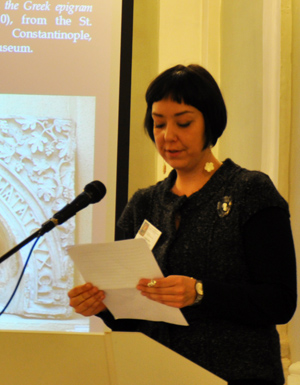Alessandra Avagliano
Sapienza University, Rome, Italy
Supervising professor: Prof. Alessandra Guiglia
The Poet and the Architect: a Consideration on Byzantine Epigrams 
In Byzantium, since the earlier centuries, it was common to use long dedicatory inscriptions carved on buildings. Usually they were long epigrams (sometimes in hexameters), in which there was a celebration of the commissioner and occasionally a description of the building itself. These texts were characterized by a high linguistic profile with continuous references to classical works, especially homeric.
Some notable examples are the epigrams on the church made under the patronage of Juliana Anicia, St. Polyeuktos, passed by the Anthologia Palatina and the ones on the Justinian churches of St. Peter and Paul and St. Sergius and Bacchus. The latter is the only epigram still sculpted on moulding around the naos. The Saint Polyeuktos’ epigram is now preserved in the Archeological Museum in Istanbul, while the epigram that belonged to the church of St. Peter and Paul is lost. Other examples belonged to other buildings in later times, like Macedonian and Paleologian age.
As easily understandable, these texts were tightly linked to the building they were sculpted on, being a part of the decoration itself. It is necessary to analyze the epigram itself and its connection with architecture and Byzantine society, in which they were written. Ancient and late ancient rhetoric in Byzantium was maintained through time and the “high language” was fundamental in literature. The expansion of literacy was advanced, also in lower social spheres, and there were primary schools even in the countryside. It can be suggested that these epigrams were conceived not only to be seen but also to be read.
For all these reasons, a comparative analysis of written texts, architecture and culture mileu can provide new stimulus for reflection.

 RU
RU  EN
EN